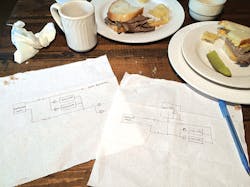In film reviews and his Movie Answer Man column, critic Roger Ebert would remind readers of Ebert’s Law, which states: “A movie is not about what it is about. It is about how it is about it.” At HPAC Engineering, we have been thinking a lot about how our content is about what it is about, which has inspired us to experiment with content forms not typically seen in technical publishing.
Adventures of Johnny Tundra, Cold-Weather Engineer
This started in late 2014 with the decision to reintroduce Johnny Tundra, Cold-Weather Engineer. For those who have yet to make his acquaintance, Johnny is the creation of longtime HPAC Engineering Editorial Advisory Board member Ron Wilkinson. When Ron became a commissioning authority around the turn of the millennium, most commissioning case studies focused on problems of moisture incursion in air-conditioned buildings in hot and humid climates. Ron wanted to call attention to cold-weather problems in Northern Tier states and do it in a way “that was fun and that described the American ‘can-do’ attitude in the context of actual engineering problems.” The result: a series of mystery/adventure stories starring the “troubleshooter from Big Timber,” Johnny Tundra.
A combination of John Wayne and fictional detective Hercule Poirot, Johnny is “calm, cool, and irreversibly logical,” Ron said. He travels the Montana countryside in his 1972 International Harvester Scout, his 15-year-old basset hound, Gas Train, by his side, helping his facility-manager friends solve perplexing problems in their buildings.
Ron wrote about a dozen Johnny Tundra stories for HPAC Engineering in the mid-2000s. As previously confessed, we never figured out what to do with such unique content in terms of presentation and promotion. As a result, the series struggled to find an audience and, after a year or two, fizzled out.
Flash forward about six years. With inroads we had made on social media and enhanced capabilities afforded by our content-management system, the time for a revival of Johnny Tundra seemed right, so we contracted with an illustrator with the idea of “rebooting” Johnny Tundra as a series of “graphic galleries.”
The reformatted Johnny Tundra premiered in May 2015. The response, particularly from the education community, was immediate.
“We all need a ‘stitch’ to connect with students,” one educator said. “Johnny Tundra can help us with that. … I would like to be able to share the adventures of Johnny Tundra with my HVACR and power-engineering students because I see this as a way to help connect at a deeper level with them.”
Other comments from educators included:
- “I think short ‘graphic galleries’ like this one could get the students thinking and the exchange of ideas flowing!!”
- “We want to have these all over our training regimen. A visual is important, and the message is clear.”
- “Great series! Thanks for the entertaining and enlightening stories.”
- “Always a positive approach to solving the mysteries that we face in the field. Good comment regarding commissioning.”
We have published eight Johnny Tundra graphic galleries to date. You can access them here.
Lunching and Learning
While we prepped the return of Johnny Tundra in early 2015, I was contacted by Jeffrey Newcomb, a consulting engineer who asked if I would be interested in an article on decoupling chilled-water production from its consumption. I told him I would. Two days later, he sent an article written entirely as a conversation between two engineers—the fictional Fred and William—having lunch. In the article, Fred, a mechanical engineer, explains his unusual design for a campus chilled-water system to William, a civil engineer. William asks questions and makes observations, system diagrams are scribbled on napkins and exchanged, and Fred is left with a new way of thinking about his design.
As much as I admired the article for its uniqueness, I was not sure how it would go over with HPAC Engineering readers, so I sent it to one.
“I love the way this paper was written,” our advisor said. “Over my 40-plus years as a consulting engineer, I have literally had hundreds of such lunch meetings. … It’s just what engineers do. The amazing part is I’ve never seen anyone write about it before!”
The formatting of the article is a clever attempt to start a conversation, to introduce a concept—one not quite fully developed—and inspire others to, in Jeffrey’s words, share “ideas that just might need to have a little more exposure to really drive more imagination and innovation in our field.”
Indeed, as if sitting at the next table, overhearing Fred and William’s conversation, our editorial advisor said: “The first time I went through it (the article), I found myself saying, ‘No, there’s a better way to do that,’ and got a piece of paper to start sketching. It could have been a placemat, but I was in my office.”
We call this series Lunching and Learning. You can read the latest installment, “Lunching and Learning: Food for Thought on a Geothermal-Heat-Pump-System Design,” here and a letter inspired by it here.
Choose Your Own (HVAC) Adventure
Particularly if you are a child of the 1980s (like I) or ‘90s, you probably are familiar with Choose Your Own Adventure (CYOA), the wildly successful series of interactive gamebooks for younger readers. Each story puts the reader in the role of the protagonist, requiring him or her to make choices that determine the main character’s actions and the plot’s outcome. Every few pages, the protagonist faces two or three options, each of which leads to more options and then to one of many endings.
Two years ago, while, oddly enough, reading that actor Neil Patrick Harris was employing the CYOA format for his autobiography, I was struck by the thought the approach could make for interesting technical content as well. I envisioned an article that served as a sort of training exercise, with the reader in the role of an engineer called to a building to investigate a comfort complaint. All of the clues the reader needs to diagnose the problem—along with a few red herrings—are presented, and the reader is challenged to identify the solution as “efficiently” as possible (i.e., by choosing correctly every time).
Our maiden voyage into CYOA territory, “License to Engineer,” by HPAC Engineering Editorial Advisory Board member, author, and blogger Larry Clark, with an assist from Ron Wilkinson, was just published online. It puts the reader in the position of a newly minted licensed professional engineer who has the option of staying in the mechanical department or transferring to the building-sciences department of his/her firm. If the reader chooses the former, he/she clicks a link that takes him/her to a story path involving the design of a fire/life-safety system as part of a hospital renovation. If the reader chooses the latter, he/she clicks a link that takes him/her to a story path involving a university research facility with chiller-efficiency issues. Both story paths require the reader to make further choices leading to different outcomes. It is a fun, entertaining read and shows the great potential of this format. Please check it out, and let us know what you think of it by contacting me at [email protected].
Opportunities to Contribute
Despite this experimentation with alternative content forms, HPAC Engineering is not turning its back on the more traditional technical features (see “Fan Selections and Their Energy Impacts, Part 2 of 2”), case studies (see “Mixed-Mode HVAC: Integrating Operable Windows With Mechanical A/C”), and commentaries that have been its stock-in-trade since 1929. If you are interested in contributing content to HPAC Engineering, the best first step is to contact me at 216-931-9980 or [email protected]. In the meantime, if you are looking for inspiration, you can download our editorial calendar for the remainder of 2016 and, soon, for 2017 here.
I hope to hear from you.
About the Author
Scott Arnold
Executive Editor
Described by a colleague as "a cyborg ... requir(ing) virtually no sleep, no time off, and bland nourishment that can be consumed while at his desk" who was sent "back from the future not to terminate anyone, but with the prime directive 'to edit dry technical copy' in order to save the world at a later date," Scott Arnold joined the editorial staff of HPAC Engineering in 1999. Prior to that, he worked as an editor for daily newspapers and a specialty-publications company. He has a bachelor's degree in journalism from Kent State University.



